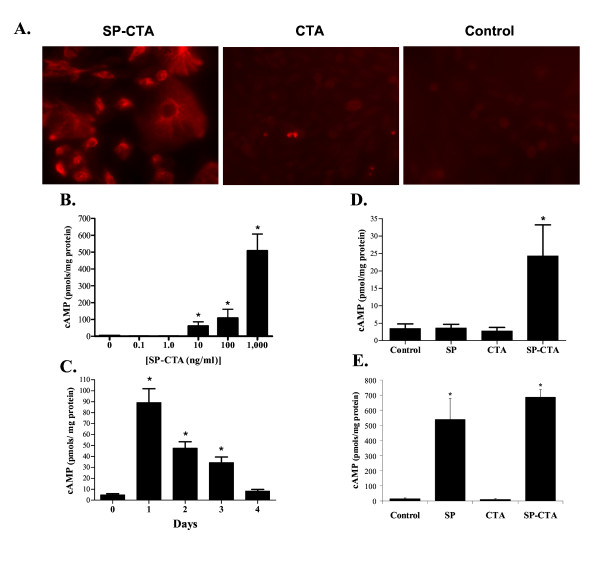Figure 2.

In situ evaluation of SP-CTA. A. CHO cells stably transfected with the NK1 receptor were treated with either SP-CTA (1 μg/ml), CTA (1 μg/ml) or were not exposed to any agents (Control). The cells were cultured over night in these solutions and then immunocytochemistry was performed on the cells using an antibody to CTA and Rhodamine-tyramide amplification. Labeling was observed only in the SP-CTA treated cells. B. Concentration response relationship for SP-CTA on cAMP production. CHO-NK1 cells were exposed to the indicated concentrations of SP-CTA for 1 hour. The cells were cultured for another 24 hours following washout of the SP-CTA with fresh culture media. The cells were harvested and cAMP content was measured using a commercial cAMP assay. (N = 5, 100 mm plates/concentration) (ANOVA F = 56.15, df = 83, p < 0.0001). C. Time course of SP-CTA's effects on cAMP content of CHO-NK1 cells. The cells were incubated for 1 hour with 100 ng/ml SP-CTA and cultured in fresh media for the indicated times. The cells were then harvested and analyzed for cAMP content. (N = 5, 100 mm plates/treatment) (ANOVA F = 25.35, df = 29, p < 0.0001). D. Comparison of the effects of substance P (SP), the catalytic subunit of cholera toxin (CTA) and SP-CTA on cAMP production in CHO-NK1 cells. Cells were incubated with 100 ng/ml of CTA, SP, SP-CTA or received no treatment for 4 hours. The cells were then cultured for 48 hours in fresh media, harvested and assayed for cAMP content. (N = 5, 100 mm plates/treatment) (ANOVA F = 5.27, df = 19, p = 0.0102) E. Further comparison of the effects of SP, CTA and SP-CTA on cAMP production. Cells were treated as described in D except the agents remained in the culture media for the full 48 hours. The cells were then harvested and analyzed for cAMP content. (N = 5, 100 mm plates/treatment) (ANOVA F = 23.06, df = 19, p < 0.0001). Data are expressed as means ± SEM. Asterisks indicate p < 0.05 one way ANOVA followed by Dunnett's test, F = 23.06, df = 19).
